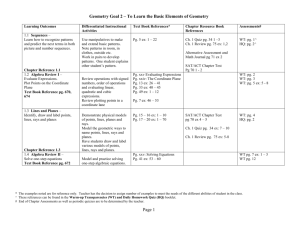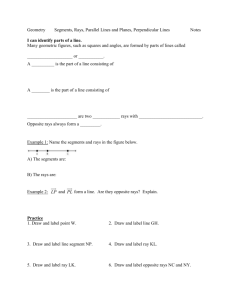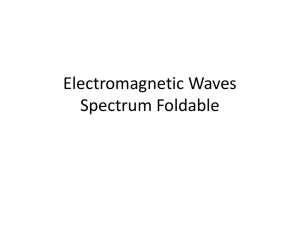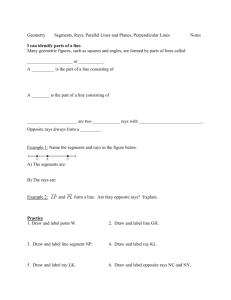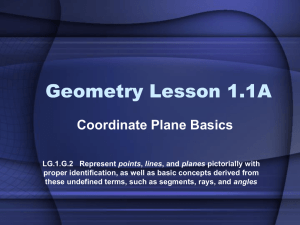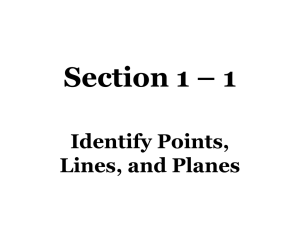Supplementary Information
advertisement
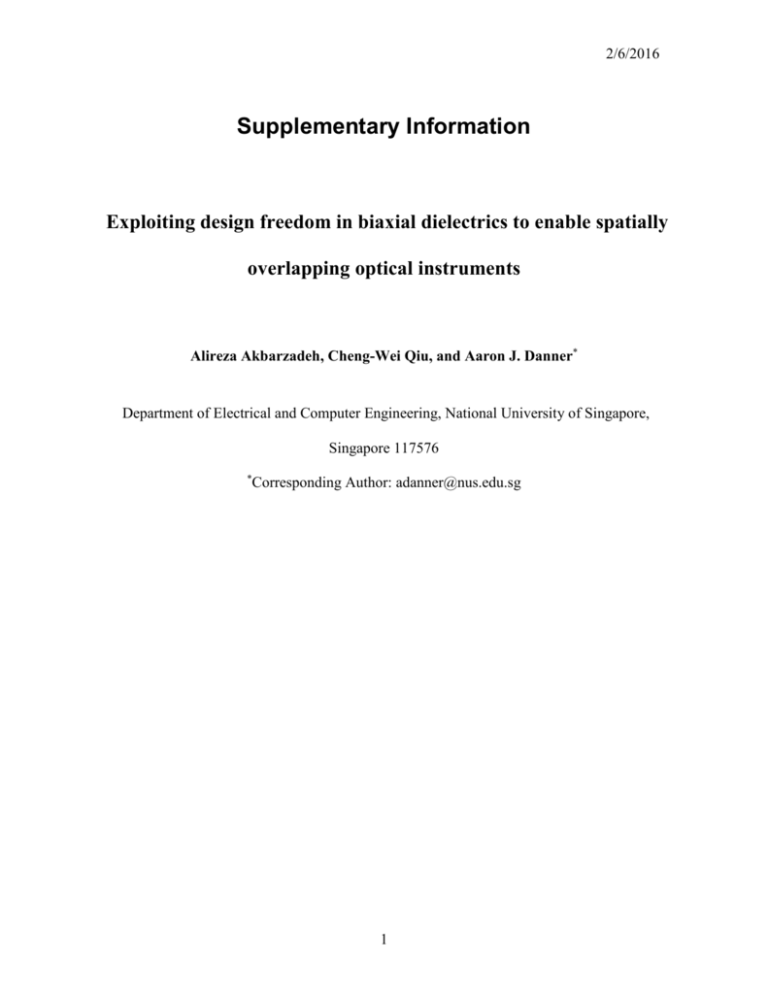
2/6/2016
Supplementary Information
Exploiting design freedom in biaxial dielectrics to enable spatially
overlapping optical instruments
Alireza Akbarzadeh, Cheng-Wei Qiu, and Aaron J. Danner*
Department of Electrical and Computer Engineering, National University of Singapore,
Singapore 117576
*
Corresponding Author: adanner@nus.edu.sg
1
2/6/2016
1. Hamiltonian of the Dielectric Biaxial Media at a Glance
In the principle coordinate system a dielectric biaxial medium has
1, diag n12 , n22 , n32
(1)
where n1 , n2 and n3 are the refractive indices along the principle axes and diag refers to the
diagonal tensor elements. The Hamiltonian of a biaxial medium in the principle coordinate
system is of the form [1]
(
)
H = k14 n12 + (k22 + k32 - n12 ) k32 n32 + (k22 - n32 )n22 +
(
)
k12 k32 (n32 - n12 )- n12 (n32 + n22 )+ k22 (n12 + n22 )
(2)
where k i ( i 1, 2,3 ) are the components of the wave vectors. The Hamiltonian in a biaxial
medium is of degree four for each k i and hence in the wave vector domain, i.e. basis vectors are
along ki components, the Hamiltonian constructs a special surface which intersects each axis at
four conjugate points. This surface, which is sometimes called the wave surface or optical
indicatrix [2], is the combination of a sphere and an oval. The three dimensional structure of the
Hamiltonian surface and its intersections with each of the ki 0 faces is shown in Figure 1S. As
seen in Figure 1S, the sphere and oval are concentric and for the case of n1 n2 n3 in general
these two meet each other at four points located in the k2 0 plane. Similar to [3], we prefer to
call these points diabolical points. The dashed lines connecting the origin to the diabolical points,
as shown in Figure 1S, are along the optical axes. The direction of the optical axes can be found
via the equations given in [4]. Except at the diabolical points, at all the other points the
Hamiltonian concentric shells are distinguishable. Due to this fact, the phase matching process
2
2/6/2016
[5] makes any incident ray at the interface of the biaxial medium refract into at most two rays
(double refraction), though we have three different indices along the axes of the principle
coordinate system. As discovered by Hamilton [6], the diabolical points are causes of one of the
most interesting phenomena in optics, conical refraction. Since at the diabolical points there is a
degeneracy in the direction of the normal to the Hamiltonian surface, the ray vectors at these
points are infinite and build up a cone [2, 3]. So due to phase matching, if the wave vector at the
interface is along one of the optical axes, then we have a conical distribution of rays within the
biaxial medium.
As explained earlier, an incident ray splits into two refracting rays at the interface of a
biaxial medium (double refraction), though in some occasions they may overlap or become
evanescent. So we should be able to factorize the Hamiltonian into two terms which can have
nontrivial roots. Now we try to find these two terms, following the method of Born and Wolf [2].
We define H 1 as
H 1 = k 2H
(3)
where k 2 k12 k22 k32 and H has been given in equation (2). With some simple algebraic
manipulations, we can write
H 1 = k12 n12 (n22 - k 2 )(n32 - k 2 )+ k22 n22 (n32 - k 2 )(n12 - k 2 )+ k32n32 (n12 - k 2 )(n22 - k 2 )×
(4)
Then by defining g n22 k 2 , g1 n12 n22 and g 3 n22 n32 , we have
H 1 = g (g - g3 )k12n12 + (g + g1 )(g - g3 )k22n22 + g (g + g1 )k32n32 ×
3
(5)
2/6/2016
Now we see that H 1 is a second degree polynomial function of g , i.e. H 1 = H 1 (g ) . So we can
express H 1 as
H 1 = G (g - ga )(g - gb )
(6)
where g a and g b are zeros of H 1 and G is a nonzero constant. And from equation (3), we have
H =
H1 G
= 2 (g - g a )(g - gb )×
k2
k
(7)
Or we can express the Hamiltonian as,
H = H aH bH c
(8)
k12 n12 + k22 n22 + k32 n32
Ha =
k2
(9)
where for H a , H b and H c we have
H b ,c = - k 2 + n22 +
1
(k12 n12 + k22 n22 )(n22 - n32 )
2 (k n + k22 n22 + k32 n32 )
{
2 2
1 1
2
é
- (k22 n22 + k22 n22 )(n12 - n22 )± êk14 n14 (n22 - n32 ) +
ë
(k n (n
2 2
3 3
2
1
- n )+ k n (n - n
2
2
(k n (n
2 2
3 3
2
2
2 2
2 2
2
1
2
3
2
))
(10)
+ 2k n (n - n
2 2
1 1
0.5
- n12 )+ k22 n22 (n12 - n32 ) ù
ú
û
)
2
2
2
3
)
}
It might be interesting to see the shape of the Hamiltonian surface and the corresponding
shells according to these factorized terms. Of course the whole shape of the Hamiltonian surface
4
2/6/2016
would be the same as that shown in Figure 1S(d). But H a ´ H b and H c individually have
different shapes than the oval and the spherical forms mentioned in Figure 1S. The three
dimensional schematic of these two shells and their intersections with ki 0 planes ( i 1, 2,3 )
are depicted in Figure 2S. It is seen that by combining the schematics in Figure 2S(a) and Figure
2S(b) we obtain the corresponding schematic shown in Figure 2S(c). By factorizing the
Hamiltonian, we actually have divided the Hamiltonian into outer and inner shells with true
optical axes and obviously their combination gives us the whole Hamiltonian surface. As will be
explained later, the advantage we can take of such a factorization is the ability to control the
biaxiality in order to design devices offering different responses to different polarizations.
Functionalities which are not available in natural isotropic or anisotropic media can be readily
achieved.
2. Controlling Biaxiality
In this section, we discuss the details of how to control biaxiality in order to engineer the
behavior of a biaxial device so that it can acquire different functionalities for each polarization.
Due to double refraction at the interface of a biaxial medium, any unpolarized incident ray
(wave) splits into two polarized rays (waves) with reference to the alignment of the electric field;
the in-plane and out-of-plane polarizations [2]. In the previous section, the Hamiltonian in a
biaxial medium was factorized into two terms which are individually describing the behavior of a
ray with one of the two polarizations along a plane of interest. So by manipulating each of these
two terms we would be able to control the behavior of each polarized ray. Unfortunately along
an arbitrary plane the factorized expressions become very complicated and therefore it seems to
be a very hard task to engineer the incident polarizations. However, as shown in the next
5
2/6/2016
subsection, along principle planes (i.e. one of k i vanishes) of biaxial media the factorized terms
turn out to be simple and acquire forms similar to those in uniaxial media. Next we give a
general recipe on how to make these polarizations act independently in a single spherical device
along such planes. Although the following analysis is for spherical geometry, we believe that it
can be extended to any other type of geometry.
2.1.
General Idea
The main goal here is to design a dielectric graded index sphere with a radially
symmetric biaxial permittivity profile. This device is required to show different functions in its
equatorial and polar planes. Due to two possible polarizations in each of these planes, the
designed lens offers generally four functions in the planes of interest. This is the immediate
interpretation, although the prospective biaxial profile of the sphere is radially symmetric and
contains only three elements in its permittivity tensor.
In order to obtain the desired profile, it would not be advisable to simply play with
permittivity elements in a random or blindly numerical manner. By simply changing the
permittivity elements, at most we can design the functions of in-plane polarizations in the main
two planes and most likely the behaviors of the out-of-plane polarizations would be out of our
hands (essentially they would be sacrificed, just as they generally would be in devices designed
with transformation optics but implemented in dielectrics). To find a way out of this problem, we
use transformation optics to open some space in the physical domain for correcting the paths of
the rays with out-of-plane polarizations, while the opened space cannot be seen by the in-plane
polarized rays. Therefore, we can still use transformation optics, but correct the paths of the
otherwise sacrificed rays with out-of-plane polarizations.
6
2/6/2016
Before going further, we prefer to mention what we mean by equatorial and polar planes.
If we assume north and south poles for a sphere in a coordinate system like {eˆr , eˆ , eˆ } , the large
circular plane which divides the sphere into northern and southern hemispheres is called the
equatorial plane. All the longitudinal great circles which are perpendicular to the equatorial circle
and crossing both poles are called polar planes. These two types of planes are shown in Figure
1(a) of the main article. It should be noted that in any sphere, we have a unique equatorial plane
and an infinite number of polar planes and our designed device is supposed to represent two
specific functions along the equatorial plane and two other functions along all the polar planes.
According to Figure 1(b) in the main text, the normal vector to the equatorial plane at the
boundary of the sphere is along ê , while along each of the polar planes the normal vector is
parallel to ê . If we break the incident fields into in-plane and out-of-plane polarizations, then
despite its general complicated form, the Hamiltonian of a dielectric biaxial medium with the
permittivity tensor diag r nr2 , n2 , n2 in a spherical geometry along the
equatorial and polar planes can be simplified as
H equatorial kr2 k2 n2 k2 n2 kr2 n2 nr2
H polar kr2 k2 n2 k2 n2 kr2 n2 nr2
(11)
(12)
where k eˆr kr eˆ k eˆ k is the wave vector. It should be noted that we assume the designed
spherical lens is radially symmetric, i.e. ni ni r where i r , , , and also has a radius equal
to one. Nonetheless the radius of the lens can have any value and we are able to rescale all the
diagrams and equations represented in this paper. As noted earlier, we cannot trivially assign
7
2/6/2016
functions to the permittivity components, for according to equations (11) and (12) they are
playing a coupled role in formation of the Hamiltonians governing each ray. So in order to
achieve the proposed device through this method, we have to overcome several restrictions as
will be explained in subsequent sections.
2.2.
Designing for In-plane Polarizations
It is well-known that with the use of transformation optics, one can open space inside a
medium to cloak an object [7, 8]. Here, we can open a hole with radius a at the center of our
device to have some space to correct the ray trajectories for the out-of-plane polarizations. Now
suppose for the in-plane polarizations we would like the spherical device to offer function “A”
for equatorial rays and function “B” for polar rays. And also suppose that these two functions
can be individually implemented via isotropic and radially symmetric index profiles. Let us take
the isotropic profiles of functions A and B as ne r and n p r , respectively, where these two
profiles are impedance matched with the vacuum at the boundary, i.e. ne r 1 np r 1 1 .
Then we consider ne r and n p r as virtual indices and we apply transformation optics to
them. If we employ transformation functions rr rr R and rr rr R , where 0 rr 1 and
0 rr 1 refer to the virtual space along equatorial and polar planes and a R 1 denotes the
physical space, then after performing some sort of normalization similar to that shown in [9], we
obtain the following equations for the transformed permittivity components,
2
2
2
2
r
drr
2
2 r
2 rr
2
2 drr
2
2
diag nr ne n p , n n p
, n ne
R
dR
R
dR
8
(13)
2/6/2016
where ne and n p should be expressed in terms of R , i.e. ne ne rr R and np np rr R .
Additionally, according to the basic theory of transformation optics, we should have
rr R
R 1
rr R
R 1
1 and drr dR
drr dR
R 1
R 1
1 . We also let 1,1,1 in the
physical space.
It is important to note that in equation (13) we have used the transformation rr R in the
equatorial plane and rr R in the polar plane of the virtual medium to find n R and n R ,
respectively. However, through this trick we would normally obtain two expressions for nr R ,
which is physically impossible. Thus we have to choose proper expressions for rr R and
rr R so that the two expressions for nr R become equal to one another. Or simply from the
first equality in equation (13) we should have
ne rr n p rr
(14)
If we take derivatives from both sides of equation (14), we obtain
ne
drr
dR
dn p drr
dne drr
dr
n p r
drr dR
dR drr dR
(15)
At the boundary of the lens R 1 , we have then
dne r
dr
r 1
dn p r
dr
r 1
(16)
where we have omitted the subscripts in (16). Equation (16) actually inserts a restriction on the
choice of ne and n p . Not any pair of well-known profiles like the Eaton lens, Maxwell fish-eye,
9
2/6/2016
invisible sphere, etc. [8] may satisfy this condition. Here in order to overcome this obstacle, we
break each of the ne r and n p r profiles into inner and outer layers,
ni1 r r1 r 1
ni r
ni 2 r 0 r r1
(i e, p)
(17)
where we can assign any value between 0 and 1 to r1 . However, for ease in later calculations,
we prefer r1 to be bigger than a , i.e. 0 a r1 1 . Then we have to design the respective
profiles of these two layers so that they become continuous at r r1 and also all the incoming
rays spiral into the inner layer as shown in Figure 3S.
In order to make all the rays spiral into the inner layer, we just need to assign a function,
which is equal to one at r 1 and bigger than 1 r in the range r1 r 1 , to ni1 r [9]. However,
the assigned function should be the same for ne and n p as we want to satisfy (16). As a
consequence, an infinite number of functions can do the job for ni1 r . One among these
functions is
ni1 r
3
1
43
4r
4
(18)
This specific function is shown in Figure 4S. It is seen that this function is equal to one at r 1
and also is bigger than 1 r in the range 0 r 1 without considering what the value of r1 might
be.
In order to design the index profile within the inner layer, we follow the implicit
integration explained in [8, 10]. We identify the impact parameter b of every spiraling ray at the
boundary of the inner layer. And according to the formation of ray trajectories corresponding to
10
2/6/2016
functions A or B, we would be able to determine the turning angle b toward the origin as a
function of the impact parameter. Then we can calculate the profile index inside the inner region
by solving the following integral equation for ni 2 r ,
n 1
ln i 2
nouter
where rni 2 Bnouter and nouter ni1 r
r r1
r1
r
r1
1
b db
b 2 r12 2
(19)
.
Then with the use of transformation optics, we open a hole at the center of the device
which is not seen by the in-plane polarized rays along both the equatorial and polar planes. But
this opened hole is sensed by the out-of-plane polarized rays. So we can use this space
effectively to engineer the trajectories of rays with out-of-plane polarizations without disturbing
the performance of in-plane polarized rays. To do so, we should let all the out-of-plane polarized
rays enter the central opened hole. As interpreted from (11) and (12), out-of-plane polarized rays
in the equatorial plane (polar planes) act as if they were in an isotropic medium with a refractive
index of n ( n ). In order to make the out-of-plane polarized rays spiral into the central space,
similar to before we should have
n R , n R
1
R
for a R 1
(20)
It should be remembered that in (20), n and n are expressed in terms of R in the physical
space. For the ease of subsequent calculations, we prefer to apply the transformation function
over the inner layers of the virtual space, i.e. we choose a to be smaller than r1 , so that the
transformation functions will not affect the outer layers and hence the physical and virtual spaces
11
2/6/2016
overlap in the range r1 R 1 . Consequently, the inequality in (20) should be slightly modified
as
n R , n R
1
R
for a R r1
(21)
In addition, we also remember that in order to have a single expression for nr R at the
end, equation (14) should be fulfilled. Therefore, enough care should be taken to choose
appropriate transformation functions, rr and rr , such that both (14) and (21) are satisfied. The
transformation functions should basically have the following properties,
r
r
0
r R a r R a
rr R r1 rr R r1 r1
drr dR R r1 drr dR
2.3.
(22)
R r1
1
Designing for Out-of-plane Polarizations
Referring to the Hamiltonian of the biaxial medium, the out-of-plane polarized rays in
equatorial and polar planes behave as if they were in isotropic media with refractive indices n
and n , respectively. In this part of the design we require both n R and n R to have values
bigger than 1/ R over all the range a R r1 . In addition to that, we know that in the range
r1 R 1 , along both of the planes n R and n R are equal to ni1 R , as the virtual and
physical spaces are the same there. Hence, all the rays with out-of-plane polarizations along
these two planes spiral into the region R a . And since this region is invisible to the in-plane
polarized rays, we can use it to independently engineer the ray trajectories with out-of-plane
12
2/6/2016
polarizations. To do so, we resort to the integral equation represented in (19) again. But this time
we have in the equatorial plane nouter n R
R a
and in the polar planes nouter n R
Ra
.
Then considering two other arbitrary functions like “C” and “D” for the out-of-plane rays along
equatorial and polar planes, we can calculate the turning angles b and solve the related
integral equations for n R and n R in the region R a .
2.4.
A Specific Example
Now let us assume that function A (corresponding to ne ) to be a 90 degree deflector of
rays and function B (corresponding to n p ) to be a 180 degree deflector of rays (equivalent to the
performance of an Eaton lens [8]). For these two specific functions, we have calculated the
refractive index distributions in the inner layers and the respective graphs for ne 2 r and n p 2 r
are given in Figure 5S, where we have taken r1 0.85 .
As said before, both ne r and n p r have two parts which are continuous at the
boundary of inner and outer layers. The inner parts are ne 2 r and n p 2 r , which are touching
each other at r r1 . The outer parts are set equal to ni1 r which is bigger than 1 r to make the
rays spiral from the outer layers into the inner layers. At r 1 , we have ne n p 1 and
dne dn p
, which shows that the restriction of (16) is satisfied. The ray trajectories for such
dr
dr
refractive index distributions are depicted in Figure 6S.
So far we have found two proper index profiles, which are satisfying (16), along
equatorial and polar planes in the virtual space. Now we are prepared to apply convenient
transformation functions on these two profiles to obtain the permittivity elements according to
13
2/6/2016
equation (13) in the physical space. Writing the transformation functions rr R and rr R in a
linear or nonlinear series of some basic mathematical functions and finding the corresponding
coefficients with simple but tedious numerical techniques, we would be able to approach the
proper transformation functions which can do the job. The transformation functions, which we
have found for the case a 0.34 , are shown in Figure 7S. It is seen in Figure 7S that the
obtained transformation functions are satisfying all the conditions described in equation (22).
Without loss of generality, we added one more restriction on the transformation functions when
we were calculating them and the reason will be apparent soon. In fact we let first few
derivatives of both transformation functions at r a be zero.
In calculating the transformation functions we actually searched for mathematically welldefined (continuous and integrable) functions which must fulfill equation (14) firstly. Secondly
we looked at the resulting profiles for n R and n R to see how well they satisfy the
inequality expressed in (20). The profile indices (or equivalently the permittivity elements)
nr R , n R and n R according to the calculated transformation functions are depicted in
Figure 8S(a) and Figure 8S(b). The performance of the designed profiles for the in-plane
polarizations along equatorial and polar planes are also provided in Figure 8S(c) and Figure
8S(d), respectively.
According to Figure 8S, the in-plane polarized rays in the polar planes bend 180 degrees
around a central cloaked space and exit in a reverse direction with respect to the incoming rays.
The trajectories of rays with an in-plane polarization in the equatorial plane are turning by 90
degrees around the same circumscribed space. It is shown in Figure 8S(a) that with help of the
transformation functions depicted in Figure 7S, we can find a unique profile for nr R . Through
14
2/6/2016
Figure 8S(b), it is seen that both n R and n R are zero at R a , which is expected due to
the vanishing first few derivatives of the transformation functions. Moreover, according to
Figure 8S(b) these two profiles are not bigger than 1/ R (highlighted with the dot-dashed line) in
the range a R a , where a 0.51 . Unfortunately this is against what is required in (21),
although n R and n R are satisfying (21) over a R r1 . Here is the place to explain why
we chose the first few derivatives of the transformation functions to be zero. Due to the quasimaximally flat nature of the transformation functions around R a (Figure 7S), the radial index
nr R has very small values within a R a region and this fact causes this region to work
like some sort of null space and therefore, as is clear from Figure 8S(c) and Figure 8S(d),
practically all the rays accumulate somewhere outside this region. So if we expand the size of the
inner cloaked space from R a to R a (as shown in Figure 8S(c) and Figure 8S(d) by
fleshes), we can have n R and n R fulfilling (21), as well as not deteriorating the
performance of the device for in-plane polarizations. However, the invoked extension may lead
to sacrificing rays with extremely low impact parameters, albeit these kinds of rays are usually
discarded in graded index optical devices anyway (and the percentage of affected rays can be
designed to be made arbitrarily small).
Having completed the design for in-plane polarized rays, we are now prepared to design
the profile indices in the region 0 R a to make our example device work for the out-of-plane
polarizations. For this example, we have chosen function C to be a 360 degree deflector of
incoming rays, which is similar to the performance of the invisible sphere explained in [8, 9]. We
also can assign function D to be a 135 degree deflector of rays. Thanks to our extension of the
cloaked area, both n R and n R have values bigger than 1/ R all over the range a R 1 .
15
2/6/2016
In order to find the profile indices in the region 0 R a for the considered functions (C and
D), we should use the integral equation (19). It should be noted that in computing the profile
indices, we should let nouter n R
R a
in the equatorial plane and nouter n R
R a
in the
polar planes. The calculated profiles n R and n R over the range 0 R a for these two
functions are shown in Figure 9S(a) and Figure 9S(b), and the corresponding ray trajectories are
also shown in Figure 9S(c) and Figure 9S(d). It is seen that the out-of-plane polarized rays in
both planes are spiraling into the first and second layers and then are getting deflected
inhomogeneously.
References for Supplementary Information
[1]
Akbarzadeh, A. & Danner, A. J. Generalization of ray tracing in a linear inhomogeneous anisotropic
medium: a coordinate-free approach. J. Opt. Soc. Am. A 27, 2558-2562 (2010).
[2]
Born, M. & Wolf, E. Principles of Optics (Cambridge University Press, Cambridge, 1999).
[3]
Berry, M. V. & Jeffrey, M. R. Conical diffraction: Hamilton’s diabolical point at the heart of crystal optics.
Prog. Opt. 50, 13-50 (2007).
[4]
Sluijter, M., de Boer, D. K. & Urbach, H. P. Ray-optics analysis of inhomogeneous biaxially anisotropic
media. J. Opt. Soc. Am. A 26, 317-329 (2009).
[5]
J. A. Kong, Electromagnetic Wave Theory (Wiley, New York, 1986).
[6]
Hamilton, W. R. Third supplement to an essay on the theory of systems of rays. Trans. Royal Irish Acad.
17, 1-144 (1837).
[7]
Pendry, J. B., Schurig, D. & Smith, D. R. Controlling electromagnetic fields. Science 312, 1780-1782
(2006).
[8]
Leonhardt, U. & Philbin, T. G. Geometry and Light: The Science of Invisibility (Dover, New York, 2010).
[9]
Danner, A. J., Tyc, T. & Leonhardt, U. Controling birefringence in dielectrics. Nat. Photon. 5, 357-359
(2011).
16
2/6/2016
[10] Danner, A. J. Singularity removal in optical instruments without reflections or induced birefringence. New
J. Phys. 12, 113008 (2010).
17
2/6/2016
(a)
(c)
(b)
(d)
Figure 1S (color online). Schematic of the Hamiltonian surface for a biaxial medium with n1 1 , n2 2 and
n3 3 ; (a,b,c) intersection with k2 0 , k3 0 and k1 0 planes, respectively, (d) three-dimensional
representation which is cut from the sides to show more detail.
18
2/6/2016
(a)
I
II
II
III
I
II
III
I
II
III
IV
(b)
IV
(c)
IV
Figure 2S (color online). Schematic surfaces of the factorized terms and the shape of the full Hamiltonian; the
intersections and three dimensional shapes of (a,I-IV) H a ´ H b , (b,I-IV) H c , (c,I-IV) H = H a ´ H b ´ H c . Note that
the schematic in c(IV) is cut from the sides to show more detail.
19
2/6/2016
Figure 3S (color online). The two layered profiles of ne r and n p r . As can be seen, all the incoming rays
should spiral into the inner layer.
Figure 4S Diagrams of ni1 r and 1 r .
Figure 5S Refractive index distribution for functions in the outer and inner regions of the lens along equatorial
(Function A) and polar planes (Function B) in the virtual medium
20
2/6/2016
(a)
(b)
Figure 6S (color online). Ray trajectories in virtual space; (a) 90 degree bending (function A) along the equatorial
plane corresponding to ne r , (b) 180 degree bending (function B) along polar planes corresponding to n p r .
Figure 7S The proper transformation functions which are obtained through a basic numerical manipulation for
a 0.34 and r1 0.85 . The dotted line r R shows that the transformation functions are eventually tangent to this
line.
21
2/6/2016
(a)
(b)
(c)
(d)
Figure 8S (color online). (a,b) Profile indices in the range a R r1 for the desired biaxial device, (c) The
performance of the device for the in-plane polarization along a polar plane, (d) The performance of the device for
the in-plane polarization along the equatorial plane.
22
2/6/2016
b
a
c
d
Figure 9S (color online). (a,b) The obtained profile indices in the range of 0 R a for the desired biaxial device,
(c) The performance of the device for out-of-plane polarized rays along a polar plane, (d) The performance of the
device for out-of-plane polarized rays along the equatorial plane.
23

